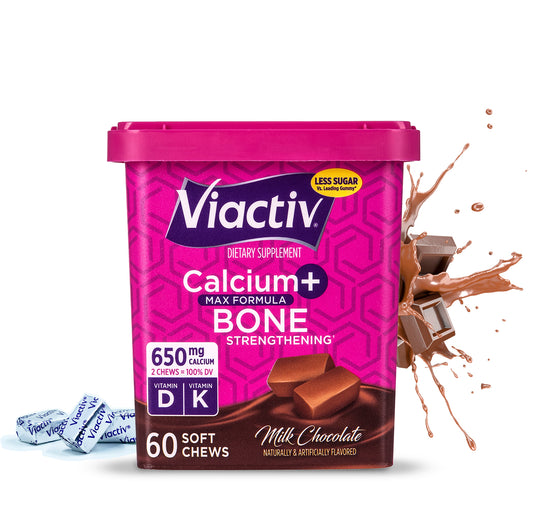Three keys to strengthen bones are diet, activity, and supplementation. For women and men, developing and maintaining peak bone mass is key for healthy aging. Research shows that 90% of Peak Bone Mass (PBM) is acquired by the age of 18. However, studies have shown that bone mineral density can continue to increase approximately 5-15% until around the age of 30. Therefore, optimizing peak bone mass during adolescence and early adulthood has been shown to support and maintain bone mass as we age. Adequate amounts of calcium and vitamin D as part of a healthy diet – along with physical activity – may reduce the risk of osteoporosis in later life.† In contrast, inadequate intakes of calcium and vitamin D may lead to reduced calcium absorption and, potentially, to bone loss.
Here are 3 key ways on how to strengthen bones:
1. Eat Calcium Rich Foods to Increase Bone Mass

The Food & Drug Administration (FDA) recommends 1,300mg of calcium per day for anyone over 4-years-old to help increase bone mass and strengthen bones. Unfortunately, 90% of women aren’t getting enough calcium and 50% of women with bone loss have inadequate intakes of vitamin D3. The best way to meet daily requirements is through dietary sources of calcium which include almonds, oranges, soybeans, garbanzo, white and pinto beans, low-fat dairy such as milk and yogurt, and leafy green vegetables such as kale, spinach, and broccoli.
2. Take a Bone Strength Supplement

In addition to including calcium rich foods in your diet, make sure you’re taking a bone strength supplement that includes both calcium and vitamin D3. Viactiv Calcium chews deliver 650mg of calcium and 500IU of vitamin D3 in each serving. That’s the same amount of calcium in 2 glasses of milk in just one calcium chew, on top of all the all the benefits of vitamin D3.
3. Be Active to Protect and Strengthen Bones

Daily activity or exercising on a regular basis also protects bone mass health. In fact, weight-bearing exercises such as walking, jogging, and weight training are especially helpful in preventing bone mass loss. Simply moving more throughout the day supports bone health, too. It doesn’t have to be for long periods of time, according to the United States Surgeon General, 30 minutes daily is the goal. The best part is that this 30-minute goal can be divided into “snacks” of exercise for 10 minutes each. Research indicates that women who sit for more than 9 hours a day are 50% more likely to have a hip fracture than those who are less sedentary.
Support your bone health by incorporating more walking and standing into your day by:
- Parking farther away from buildings
- Taking the stairs instead of the elevator
- Walking around your office while on work calls
If you work from home, incorporate more walking and standing into your day by:
- Taking 10-minute walking breaks inside or outside of your home every few hours
- Slowly repeat sitting and standing from your desk chair without pushing off (Legs only!) for 3 sets of 10 or for 3 minutes at a time
- Walking up and down your stairs for 10-minutes every few hours, even if you only have a few stairs. Walking up and down stairs is not only great for lower body strength, but it also has cardiovascular benefits for your heart and your lungs
Maintaining healthy bones may be as easy as:
- Consuming calcium-rich foods
- Taking Calcium plus vitamin D bone strength supplements, like Viactiv Calcium soft chews
- Being active daily however works best for you
Sources:
Daily Value on the New Nutrition and Supplement Facts Labels | FDA
Acquisition of Optimal Bone Mass in Childhood and Adolescence | ScienceDirect
Exercise for Your Bone Health | National Institutes of Health (NIH)
Last Updated On: December 6, 2022
First Published On: October 27, 2022





